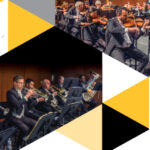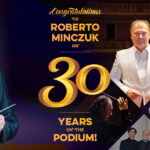Program Notes, ©2013 Lori Newman
Program Notes
Sergei Rachmaninoff Piano Concerto No. 3 in d minor, op. 30 (1909)
(Born 1873, Semyonovo, Russia; died 1943, Beverly Hills, California)
There was perhaps no greater status symbol in the United States in the early 20th century than the ownership of an automobile. So attractive was this prospect, that it played a major role in Sergei Rachmaninoff’s first tour to the United States in 1909. Automobiles were far less common in Russia, and the composer felt he could earn enough money from his American tour to procure a car in his homeland. Rachmaninoff had achieved major success in Russia, so much so, that he was overwhelmed by requests for solo performances, conducting engagements, and composition commissions. He had decided to pull back on his performing and moved his family to Dresden in 1906 so he could concentrate on composing. He spent 1906 through some of 1909 in both Dresden and Paris, composing and taking a break from his busy touring and schedule. Then America and the promise of the funds for a shiny automobile beckoned.
Rachmaninoff wrote his Third Piano Concerto to kick-off his U.S. tour in 1909, in which he had garnered engagements as soloist and conductor with some of the most prestigious orchestras in the U.S., including Boston, Chicago, Philadelphia, Baltimore, and New York. Rachmaninoff was wise in his marketing of his Third Piano Concerto, hailing that it was “written especially for America.” His Piano Concerto No. 3 premiered on November 28, 1909 with Rachmaninoff as soloist and Walter Damrosch conducting the New York Symphony. Two months later he performed the work with the New York Philharmonic with Gustav Mahler conducting. Rachmaninoff’s time spent rehearsing his Third Piano Concerto with Mahler had a profound effect on Rachmaninoff. He wrote of the experience:
Mahler was the only conductor whom I considered worthy to be classed with Nikisch [Arthur Nikisch, Hungarian, preeminent conductor of the early 20th century.] He touched my composer’s heart straight away by devoting himself to my Concerto until the accompaniment, which is rather complicated, had been practiced to the point of perfection, although he had already gone through a long rehearsal. According to Mahler, every detail of the score was important—an attitude which is unfortunately rare among conductors.
Rachmaninoff’s Third Piano Concerto was known for its incredible technical difficulty and different style than his previous two piano concertos. One of its earlier reviews stated, “The work grows in impressiveness upon acquaintance and will doubtless take rank among the most interesting piano concertos of recent years, although its great length and extreme difficulties bar it from performance by any but pianists of exceptional technical powers.” This manifested itself in a multitude of ways. Firstly, Rachmaninoff dedicated his Third Piano Concerto to his good friend, and many argued, the finest pianist of his generation, Josef Hofmann. However, Hofmann never performed the work, stating it, “wasn’t for him.” The concerto was made famous and popular by the young Vladimir Horowitz, who first challenged the concerto in 1920. When Horowitz and Rachmaninoff met, the composer suggested cutting portions of the concerto to make it more accessible and popular with audiences; some argue that this interfered with its artistic integrity, while others posited that the cuts accomplished Rachmaninoff’s vision for the work’s future. The use of these cuts became standard; Horowitz first recorded the Concerto with the cuts in 1930 with the London Symphony, and several years later Rachmaninoff recorded the work with the same cuts in 1939 with the Philadelphia Orchestra. Rachmaninoff ceded that Horowitz played his Concerto better than he did, and never performed the work again in a live performance. Since those early years, the concerto’s popularity has grown significantly, and with this new-found appreciation, the cuts are usually removed by contemporary performers and the original notes are reinstated.
One of the more striking elements of Rachmaninoff’s Third Piano Concerto is the simplicity with which it begins. An orchestral two-measure undulating pattern (slightly reminiscent of parts of his Second Piano Concerto) introduces one of the most simple and haunting melodies of Rachmaninoff’s works. He saves the fireworks in this concerto for later. There has been debate and speculation regarding the origin of the opening piano melody. A musicologist, Joseph Yasser, contrived a theory that the piano’s opening theme is a Russian liturgical chant, entitled Thy Tomb, O Savior, Soldiers Guarding. Rachmaninoff immediately dismissed the theory stating that the melody “is borrowed neither from folk song nor from liturgical sources. It simply wrote itself.” The second-movement intermezzo begins, again subdued, with an underlying pathos, made even more dramatic by the use of the oboe in the melodic writing. The strings eventually become intense, with the thematic material, but this is all before the piano has made its entrance. Once the piano enters, the listener is treated to a meandering chromatic passage leading into the main theme. The contrasting section is a scherzo in a waltz tempo, making it a very non-stereotypical concerto slow movement. The second movement ends with the character of the beginning of the movement and leads into the third movement finale without pause. The last movement resembles a frenetic march, alternating with luscious and expansive sections based on thematic material from the first movement.
The reviews of his Third Piano Concerto were not what Rachmaninoff had hoped for, especially for the highly touted “American” Concerto. He wrote, “Musicians loved it, but not the audience or critics.” It was perhaps a case of being too advanced for its time of 1909, for which an even greater debt of gratitude is owed to Vladimir Horowitz for popularizing the concerto by the 1920s. Rachmaninoff wrote to a friend when trying to decide whether or not to make the American trip of 1909, “I don’t want to go. But then perhaps, after America I’ll be able to buy myself that automobile…. It may not be so bad after all!” Rachmaninoff purchased his first car in 1912 and it is purported that he bought himself a new automobile every year after that.
Maurice Ravel Daphnis et Chloé Suite Numbers 1 & 2 (1909 – 1912)
(Born 1875, Ciboure, France; died 1937, Paris, France)
It is difficult, if not impossible, to imagine the 20th century musical landscape without the contributions of Serge Diaghilev and his Ballet Russes. Dozens of works are in the classical repertoire because they began as works for the Ballet Russes. Not all succeeded at the Ballet, but they remained in the classical oeuvre, thanks to Diaghilev. Among the masterpieces we can connect with Diaghilev are Stravinsky’s three balletic masterpieces (and the orchestral suites that were drawn from them) The Firebird, Petrushka, and The Rite of Spring. While these are the ballets that put the Ballet Russes on the map and maintain their legacy, let’s take a look at other composers that had works produced by Diaghilev: Chopin, Borodin, Rimsky-Korsakov, Schumann, Debussy, Richard Strauss, Tchaikovsky, and Prokofiev just to name a few of the famed composers with whom Diaghilev worked.
The Diaghilev subject at hand for this evening, is the ballet Daphnis et Chloé by the French Impressionist composer, Maurice Ravel. Ravel began the score for Daphnis in 1909, but had several issues with the choreography and other aspects of the ballet’s assemblage, that it was not completed until 1912. Ravel and choreographer Michel Fokine had very differing opinions about how the concluding Danse should be staged. He wrote in June of 1909, “I must tell you that I’ve had a really insane week: preparation of a ballet libretto for the next Russian season. Almost every night, work until 3 a.m. What particularly complicates matters is that Fokine doesn’t know a word of French, and I only know how to swear in Russian. Even with interpreters around you can imagine how chaotic our meetings are.” Chaotic or not, Ravel extracted his Suite No. 1 from the ballet in 1911, and the more popular Suite No. 2 in 1913.
Regardless of the backstage drama, Ravel’s ballet finally was premiered on June 8, 1912 by Diaghilev’s Ballets Russes at the Théâtre du Châtelet, conducted by Pierre Monteux. The work is considered by many to be Ravel’s masterpiece, but the ballet never really popularized, and it is in the Orchestral Suites 1 & 2 that Ravel’s vision has lived on.
The tale of Daphnis et Chloé is that of a third-century Greek poet by the name of Longus. The story centers around the title characters of Daphnis and Chloé who were abandoned as babies and raised by shepherds. As they grow up together, they eventually fall in love and their somewhat simple upbringing escalates into all sorts of adventures including abduction, pirates, divine intervention by the god Pan, and the ultimate in love’s redemption and reunion.
Ravel liked to describe his music to Daphnis et Chloé as “a choreographic symphony in three parts” in which he strived to “compose a vast musical fresco…” In his efforts to capture the spirit of Daphnis et Chloé, he wrote for an immense orchestra, employing several rarely used auxiliary instruments and large numbers in each section. He also insisted on a wind machine to be included in the orchestra, and a wordless chorus. Ravel and Diaghilev quarreled over using instruments to try and take the place of the chorus in later performances. It is not terribly surprising how the ballet ended up less than successful. Having said that, the Orchestral Suites are extremely popular and programmed quite often. The orchestration and colors alone make Ravel’s Daphnis et Chloé breathtaking and quite ripe for repeated listening. While Ravel extracted the Suite No. 1 first, it is possible he didn’t have as much information as to how the ballet would ultimately end. The Suite No. 2 was extracted after the premiere of the full ballet, thereby making it more balanced and more in line with the story.
Ravel took three scenes from the end of the ballet, after the lovers are reunited to create his Suite No. 2. He details the music from the Suite No. 2 with passion and pictorial descriptiveness: (The Roman Numerals correspond with movements IV, V, and VI in your programs.)
I. No sound but the murmur of rivulets of dew trickling from the rocks. Daphnis lies still before the grotto of the nymphs. Little by little, day breaks. Bird songs are heard. Herdsmen arrive searching for Daphnis and Chloé. They find Daphnis and awaken him. In anguish, he looks around for Chloé, who at last appears surrounded by shepherdesses… Daphnis and Chloé mime the story of the nymph Syrinx who was beloved of the god Pan. Chloé impersonates the young nymph wandering in the meadow. Daphnis appears as Pan and declares his love. The nymph repulses him. He grows more insistent. She disappears among the reeds.
II. In despair he plucks some reeds and shapes them into a flute and plays a melancholy tune. Chloé returns and dances to the melody of the flute.
III. The dance grows more and more animated and, in a mad whirl, Chloé falls into Daphnis’s arms… A group of young girls, dressed as bacchantes, enters… A group of young men invade the stage. Joyous tumult. General Dance.
While some may mourn the “failure” of Daphnis et Chloé as a successful ballet, few can argue the effect and influence it had on French music from that point forward. Perhaps Igor Stravinsky, one of Diaghilev’s goldmines, said it best: “It is not only Ravel’s best work but one of the most beautiful products in all of French music.”




